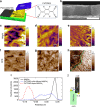Molecular doping enabled scalable blading of efficient hole-transport-layer-free perovskite solar cells
- PMID: 29691390
- PMCID: PMC5915422
- DOI: 10.1038/s41467-018-04028-8
Molecular doping enabled scalable blading of efficient hole-transport-layer-free perovskite solar cells
Abstract
The efficiencies of perovskite solar cells (PSCs) are now reaching such consistently high levels that scalable manufacturing at low cost is becoming critical. However, this remains challenging due to the expensive hole-transporting materials usually employed, and difficulties associated with the scalable deposition of other functional layers. By simplifying the device architecture, hole-transport-layer-free PSCs with improved photovoltaic performance are fabricated via a scalable doctor-blading process. Molecular doping of halide perovskite films improved the conductivity of the films and their electronic contact with the conductive substrate, resulting in a reduced series resistance. It facilitates the extraction of photoexcited holes from perovskite directly to the conductive substrate. The bladed hole-transport-layer-free PSCs showed a stabilized power conversion efficiency above 20.0%. This work represents a significant step towards the scalable, cost-effective manufacturing of PSCs with both high performance and simple fabrication processes.
Conflict of interest statement
The authors declare no competing interests.
Figures




References
-
- Correa-Baena JP, et al. The rapid evolution of highly efficient perovskite solar cells. Energy Environ. Sci. 2017;10:710–727. doi: 10.1039/C6EE03397K. - DOI
-
- Zheng X, et al. Defect passivation in hybrid perovskite solar cells using quaternary ammonium halide anions and cations. Nat. Energy. 2017;2:17102. doi: 10.1038/nenergy.2017.102. - DOI
Publication types
LinkOut - more resources
Full Text Sources
Other Literature Sources
Molecular Biology Databases

